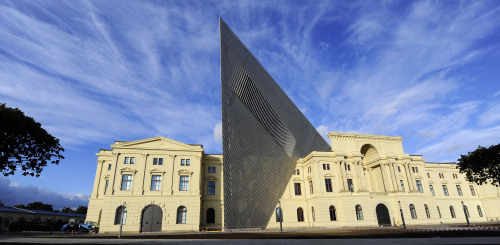DRESDEN, Germany (AP) ― A modern wedge of glass, concrete and steel rips through a 135-year-old former armory building for the armies of Kaiser Wilhelm I, its silvery shimmer and stark lines contrasting sharply with the neoclassical building that it now bisects.
American architect Daniel Libeskind knew when he won the bid to redesign Dresden’s Museum of Military History that he wanted to create a radical departure ― something symbolic of Germany’s rigid authoritarian past giving way to the liberal democracy of today.
“He said from the beginning that we must transform the building,” said Libeskind’s project leader Jochen Klein, in a preview of the building Tuesday ahead of its official reopening to the public on Saturday. “We needed to give the old building a new meaning.”
The theme of contrast is central not only to the 62.5 million euro ($85 million) renovation that was started in 2004, but to the exhibitions themselves, which rethink the approach toward military history.
American architect Daniel Libeskind knew when he won the bid to redesign Dresden’s Museum of Military History that he wanted to create a radical departure ― something symbolic of Germany’s rigid authoritarian past giving way to the liberal democracy of today.
“He said from the beginning that we must transform the building,” said Libeskind’s project leader Jochen Klein, in a preview of the building Tuesday ahead of its official reopening to the public on Saturday. “We needed to give the old building a new meaning.”
The theme of contrast is central not only to the 62.5 million euro ($85 million) renovation that was started in 2004, but to the exhibitions themselves, which rethink the approach toward military history.

There are vast arrays of militaria ― some 10,500 artifacts from the crude weapons of the early 14th century, to the V2 rocket from World War II and a large collection of tanks, to items used by the Bundeswehr today in Afghanistan. But the perspective moves beyond the focus on heroes and battles.
Starting in the peak of Libeskind’s five-story wedge, visitors see damaged paving stones from the Polish town of Wielun, where German Stuka dive bombers fired the first shots of World War II. By the stones there is a portrait of a Stuka pilot ― next to one of a 13-year-old Polish boy who witnessed the destruction of his hometown. Beyond the display, through the perforated steel of the structure, is a panoramic view of Dresden ― obliterated by Allied firebombing in the final weeks of the war and today almost entirely rebuilt.
The contrasts continue throughout the museum: An exhibit on war and children shows the lighter side, with toy soldiers and Star Wars paraphernalia, but also the dark, with a Nazi-era children’s book portraying Jews as poisonous mushrooms and a wooden puzzle that spells “Hitler” when assembled.
Another exhibit on prosthetics not only shows the innovative ways devised to deal with missing limbs, but also tells the stories of the people who wore the artificial appendages on display. A somber display on death places a steel helmet with two gaping holes through it next to the skull of an unidentified WWII solder who committed suicide by placing a gun into his mouth, next to a letter from a German mother to her son in 1944, stamped: “return to sender; died for greater Germany.”
While the modern addition contains more thematic exhibits with a focus on societal forces and the human impulses that lead to violence, the original building presents German military history in chronological order.
“If you ask the average German now they say they don’t want an army museum,” said Gorch Pieken, academic director of the museum. “I can understand that ― but this is not a classic army museum.”
All signs are in English and German, and admission is free through the end of the year.




![[Herald Interview] 'Amid aging population, Korea to invite more young professionals from overseas'](http://res.heraldm.com/phpwas/restmb_idxmake.php?idx=644&simg=/content/image/2024/04/24/20240424050844_0.jpg&u=20240424200058)











![[KH Explains] Korean shipbuilding stocks rally: Real growth or bubble?](http://res.heraldm.com/phpwas/restmb_idxmake.php?idx=652&simg=/content/image/2024/04/25/20240425050656_0.jpg&u=)

